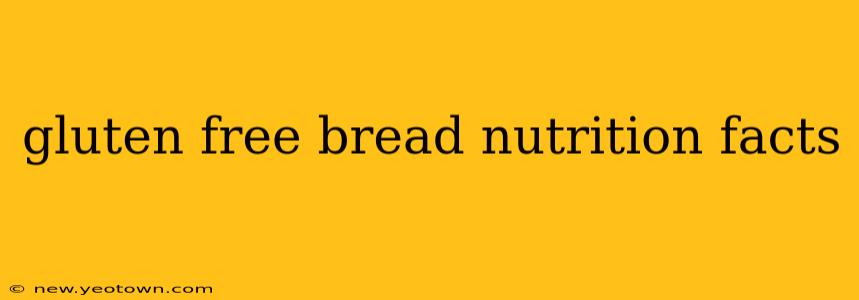Let's be honest, the transition to a gluten-free diet can feel like navigating a minefield, especially when it comes to bread. That familiar, comforting loaf is suddenly replaced by a bewildering array of options, each with its own texture, taste, and – importantly – nutritional profile. This isn't just about avoiding gluten; it's about making informed choices to maintain a balanced and healthy diet. So let's dive into the world of gluten-free bread nutrition facts and explore what you need to know.
My name is Sarah, and I've been living gluten-free for over a decade. I’ve learned firsthand the challenges and rewards of finding truly satisfying and nutritious gluten-free alternatives. This article reflects my experience and extensive research, aiming to empower you to make the best choices for your well-being.
What are the Nutritional Differences Between Gluten-Free and Regular Bread?
This is the million-dollar question! The simple answer is: it varies wildly depending on the brand and ingredients. Regular wheat bread often boasts a good source of fiber, iron, and certain B vitamins. However, gluten-free breads, because they often use alternative flours like rice flour, almond flour, or tapioca starch, can sometimes fall short in these areas. Some gluten-free loaves cleverly compensate by adding in extra nutrients, but it's crucial to check the label. One brand's "healthy" option might be another's high-sugar, low-fiber counterpart.
Is Gluten-Free Bread Lower in Calories?
Not necessarily. While some gluten-free breads might be slightly lower in calories, many are comparable or even higher than their gluten-containing counterparts. The caloric content depends heavily on the specific ingredients used. For instance, breads made with nut flours will be higher in fat and calories than those primarily made with rice flour. Always check the nutritional information panel on the packaging.
Does Gluten-Free Bread Have Less Fiber?
This is often the case, yes. Gluten-free bread frequently lacks the robust fiber content found in wheat bread. Fiber is crucial for digestive health, so if fiber intake is a concern, you'll need to be more mindful of your overall diet and potentially supplement with other high-fiber foods or seek out gluten-free breads specifically fortified with fiber.
What are the Best Gluten-Free Bread Options?
There's no single "best" option, as individual needs and preferences vary. However, when choosing a gluten-free bread, look for:
- High Fiber Content: Prioritize breads with a significant amount of fiber per serving.
- Low Sugar Content: Avoid breads with added sugars or high fructose corn syrup.
- Whole Grains: Opt for breads made with whole grain alternatives like quinoa or brown rice flour whenever possible. These tend to offer better nutritional value.
- Minimal Added Ingredients: A shorter ingredient list generally indicates fewer additives and preservatives.
Are There Any Vitamins or Minerals Missing in Gluten-Free Bread?
Gluten-free breads can be lower in certain vitamins and minerals naturally found in wheat, such as iron and B vitamins. Some manufacturers fortify their products to address this, but it's always a good idea to check the label and consider supplementing if necessary, especially if you have specific dietary concerns. A consultation with a nutritionist or dietitian is highly recommended, particularly if you're making significant dietary changes.
How Can I Make Gluten-Free Bread More Nutritious?
Beyond choosing a well-formulated gluten-free bread, there are ways to boost its nutritional value:
- Pair it with Nutrient-Rich Toppings: Add avocado, eggs, seeds, or nut butters to your toast for extra protein, healthy fats, and vitamins.
- Combine it with Other Foods: Make a balanced meal by incorporating gluten-free bread into a larger meal containing vegetables, lean protein, and healthy fats.
Navigating the gluten-free world requires attention to detail, but it's absolutely achievable. By understanding the nutritional nuances of different gluten-free breads and making conscious choices, you can enjoy delicious bread while maintaining a healthy and balanced diet. Remember to always check the nutrition labels and consult with a healthcare professional if you have specific dietary concerns or requirements.

